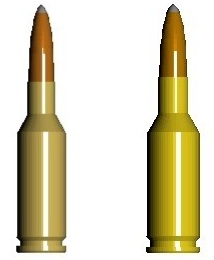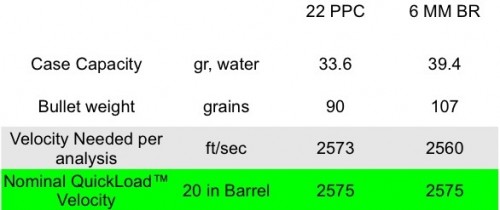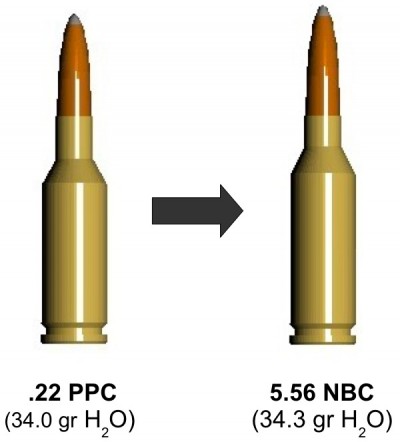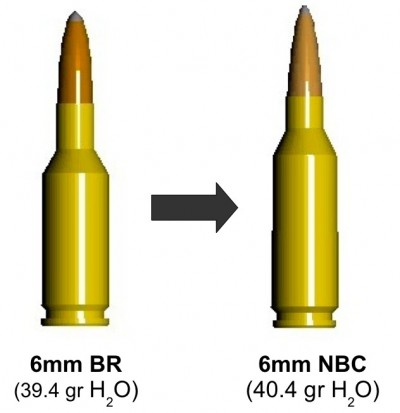| Synopsis | I. Why a New One?” | II. Terminal Effects | III. Required Velocities | IV. Velocities — Summary |
Replacing the 5.56 NATO
The 5.56 mm replacement debates have largely focused on cartridges that can function in AR-15 class rifles. This series of notes looks at the question: “What would a cartridge that could replace both the 5.56 and 7.62 NATO look like, and how would it perform?”
The term “Battle Rifle” refers to a rifle with the ability to anchor an adversary fairly reliably out to as far as 600 meters and have the other characteristics that make it a good military firearm. A number of studies from as far back as the first half of the 20th Century have concluded that a cartridge of about the size of the 25 Remington would serve very well as a battle rifle cartridge. The 6.5 Grendel, while a very useful cartridge, does not provide enough powder volume to meet the threshold velocities described in the following series of notes.Therefore the 25 Remington served as a starting point in this investigation.
The earlier notes in this series explore the principal factors involved in defining how a cartridge could show essential equivalence to the 7.62X51 NATO over the ranges normally involved in infantry engagements.
We can describe the engagement zones defining these ranges as:
- Close Quarters Battle — anything from hand-to-hand to a few tens of meters (Author’s observation, CQB is frequently viewed as synonymous with urban combat. The geometry of cities and their structures yield engagement ranges that are usually very close, but occasionally involve long range shots along streets and between multi-story buildings.)
- Canonical Infantry Engagements — a few tens of meters out to about 300 meters.
- Marksman and sharpshooter territory — out to about 600 meters
- Medium Machine guns and Specialized Snipers — out to 1200 meters and beyond.

Figure 1. The .22 PPC (left) and 6mm BR will both likely generate needed ballistics

Figure 2. Velocities from 20-inch barrels suggest that the .22 PPC and 6 mm BR both could work
Our interest spans the first three categories, plus the light machine gun. The special sniping community will continue to use cartridges and equipment best suited to the needs of the particular missions assigned to them, so are not part of the emphasis for a unified infantry cartridge. Similarly, medium machine guns and Gatling guns appear for the foreseeable future to have a role best filled by the 7.62X51 NATO round.
A mildly surprising result of the investigation is that the 25 Remington case has more volume than needed to get the desired performance with heavy .224 inch and 6mm bullets. The study suggests that the .22 PPC and 6 mm BR (Remington or Norma) have just enough capacity in their respective calibers. The volumes of these cartridges can be maintained by adjusting neck and overall length while morphing the body and shoulder tapers to permit more assured reliability in dirty, dusty, etc. conditions.
We require that the penetration and perforation potential be equal to or better1 than that of the M80 7.62X51 cartridge in a 20 inch barrel at all ranges. These were shown to be attainable with significantly smaller caliber and lighter bullets than those used in the M80 ammunition.
We find from the tables in the earlier “Velocities — Summary” that heavy bullets in these smaller calibers have a good chance to have a ballistic coefficient greater than that of the M80 round when manufactured to mass-production military standards. This higher ballistic coefficient means that the armor defeat and penetration potential will remain comparable to or better than that of the M80 at all ranges, provided the threshold muzzle velocity is obtained.
There is widespread agreement that the lethality (or incapacitation) potential of M80 ammunition is well above the levels needed for modern combat. Similar consensus indicates that 5.56 mm NATO ammunition is effective at close ranges where the bullets have adequate velocity. We can use this performance as a basis for assigning threshold lethality for the new cartridge.
Reasonably authoritative literature suggests that the threshold lethality2,3 of the M855 round is 2500 ft per second. This note uses the HITS™ score of the M855 bullet at 2500 ft per second to determine the threshold for lethality potential for different caliber and weight bullets. The comparisons assume the same or nearly the same bullet construction independent of caliber and weight. The new rounds need to have at least this score out to beyond 600 meters for the designated marksman and, preferably, out to the effective range of the light machine gun.
This brings us to the question “What cartridges give us just enough case volume to propel suitable bullets fast enough to make the cut?” Perusal of the reloading data available at http://www.ammoguide.com/ suggested that the minimum case volume should be about 40 grains of water for 6mm and .25 caliber cartridges.

Figure 3. Morphing the .22 PPC keeps the volume while getting the taper needed for reliable feeding and extraction.
The study initially considered .308 Winchester-length cartridges but the assessment finds that 5.56 mm NATO-length cartridges, e. g., cartridges based on the .308X1.5 Barnes, have about this volume and can meet the threshold ballistics in 20-inch barrels. The shorter, fatter, cartridges can be used in AR-15 class rifles by replacing the barrel, bolt and furnishing new magazines. They also can likely be implemented into rifles chambered for the 7.62 NATO by simply replacing the barrel, issuing new magazines and, when needed, new bolts.
A series of cartridges were modeled in some detail using QuickLoad™ to obtain estimates of muzzle velocities in 20 inch barrels using standard powders. The Winchester Super Short Magnum cartridges were not considered because they were too fat to get a reasonable number of cartridges in the magazine. The calculations used a maximum case fill of 100% (no compressed loads). A peak pressure of 50000 psi was imposed for the BR cartridges to keep bolt thrust in the same range as that of the 5.56 NATO and 6.5 Grendel.
The calculations suggest that a case with the capacity of the 6 mm BR Remington (or Norma) is big enough to push the heaviest bullets fast enough and one with the volume of the .22 PPC for .224 diameter bullets. Earlier preliminary modeling in QuickLoad™ suggested that PPC case volumes are marginal for the 6.5 mm and .257 caliber variants. The smaller diameter of the PPC cartridges allowed the chamber pressure to rise to 52000 psi while keeping bolt thrust at reasonable levels. Interestingly, the .22 PPC proved to generate high enough velocities that we could select this one as our baseline for the .224 inch variant. A similar cartridge is the .224 AR design based on the Grendel (http://www.6mmar.com/224_AR.html).
The big challenge with the .22 PPC and 6mm Bench Rest is that they have very little taper along the body. The nearly straight sides don’t give much margin for releasing from chamber walls that have become rough for any of many reasons, including dirt, sand, mud, etc. We can pretty much surmise that attaining this margin is the reason many of the older military cartridges, e. g., 7.62X54, 30-06, and 7.62X39 have significant body taper. Similarly, these cartridges tended to have less aggressive shoulder angles. The price paid is that the powder volume gets reduced.
In the present instance, we want the longest bullets to remain mostly outside of the case with at least one caliber of the body supported by the neck. The neck length for most modern cartridges has shrunk to about one caliber which lets us establish the maximum case length by allowing an approximately 1 caliber neck length. Applying these guidelines to morphing the .22 PPC gives the conceptual design in Figure 3.
We would also expect that the rims for the BR based cartridge would be slightly rebated to a .445-inch diameter to facilitate use of the $70.00 retail 7.62X39 bolts readily available for AR-15 rifles. This additional consideration led to the 6mm NBC concept shown in Figure 4.

Figure 4. Morphing the 6mm BR keeps the volume while getting the taper needed for reliable feeding and extraction.
- Bullets smaller in diameter than .308 can have the same potential for perforation and penetration of barriers as the 147 grain bullet when the right combination of sectional density and velocity are used.
- 90 gr .224 bullets and 6 mm bullets heavier than about 100 grains will likely have ballistic coefficients equal to or greater than the 145 – 150 grain ball used in the 7.62 NATO when manufactured to the same standards.
- Cases with volumes at least as great as that of the 22 PPC can push the 90 grain .224 bullet fast enough.
- Cases with volumes at least as great as that of the 6 mm BR Remington (or Norma) can have adequate muzzle velocities for bullets greater than about 100 grains,
- The ballistic coefficients for these bullets will keep the penetration and perforation potential at least as great as that of the 7.62 M80 round at all ranges.
- Lethality for these bullets will be adequate to well beyond 600 meters, making them a good fit for infantry applications up to and including the light machine gun role.
- Starting with either the .22 PPC or the 6mm BR appears to give a path that could produce a Battle Rifle that could serve the functions of both the 5.56mm NATO and the 7.69X51 NATO in weapons for light infantry .
These cartridges could also enjoy some interest in the sporting and competition worlds. We start by noting that the industry standard barrel length for reporting velocities is 24 inches. Adding 4 inches to the barrel length used in this study results in an additional 100 ft/sec muzzle velocity for both cartridges. Therefore both the 90 gr .224 and 107 gr .243 bullets will start out at about 2675 ft/sec. At first glance, these appear to be rather modest velocities. The 90 gr .224 bullet, however, is moving out more than 100 ft/sec faster than the heaviest handloads for the .223 Remington — and those handloads are too long to fit in the AR-15 magazine! The Hornady HITS™ methodology also tells us that 107 gr .243 bullet should perform about as well as standard factory .257 Roberts loads. These observations suggest that both cartridges would have good potential for medium game in addition to varmint and target shooting.
3Soft Target Terminal Ballistic Testing Standardization for the U.S. Military by Mr. Mark D. Minisi, Proceedings 50th NDIA Conference.
| Synopsis | I. Why a New One?” | II. Terminal Effects | III. Required Velocities | IV. Velocities — Summary |

 sending...
sending...
6.2x42mm OCC
Hi, who is the author of this article? Very interesting.
Very interesting and well thought out article. Who is the author?
I don’t want to come across as negative, especially because we seem to have independently came up with the same idea nearly vis a vis ctg similar to 22PPC with more taper. But I question the need of a universal infantry ctg. In WW2 our infantry used 3 pistol ctgs. 32ACP, 38spl, and 45ACP. The 45 ACP was also used in 3 different submachine guns. We also issued 30 carbine ammo in 2 differant carbines. The 30-06 was used in the Springfield, M1 rifle, Johnson rifle, the BAR, various sniper versions of the service rifles and the browning machine guns. Lets not forget the immortal MA Duece either. I would argue that at no time in history has our Army been better armed compared to our opponents. I don’t recall any talk of major difficulties supplying this plethora of ammo to our Army. In fact the entire idea of a universal infantry cartridge for the US Army was the 7.62 NATO and the M14. The M14 was supposed to replace the M1 Rifle, The BAR, The Thompson, The M1 & M2 carbines which were supposed to replace the pistols. We still have pistols BTW. The M14 failed miserably as a replacement for any then current weapon except the M1 rifle for which it indeed was an excellent replacement.
PS not to mention the use of the 12 guage shotgun.
I like your proposed ctgs as limted use for the DM. I think you are overstressing long range terminal performance though. For the DM role stopping power is of conern to 500 yards, past that just be happy with any wounds you inflict on the enemy. Lethal or not, its all good. I’d insist on supersonic performance to 1000 yards.